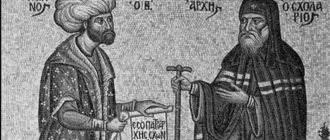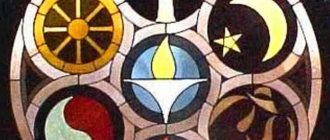Luck will smile on you!
Glagolitic is an ancient Slavic alphabet. Man has long sought to convey some information through marks, signs, and drawings. Of course, at first they were very primitive, but with the development of humanity, writing also developed, without which today we cannot imagine existing in society.
Information about the Glagolitic alphabet today, on the one hand, is numerous. But, on the other hand, all of it is not 100% confirmed. That is, we know a lot about it, but at the same time we know nothing. Let's start with the etymology of the word "Glagolitic" itself. It comes from the term “verb”, which means “word”. In general, the Glagolitic alphabet is very characterized by the presence of some meaning in everything. You will not find a single letter in this alphabet that does not carry one meaning or another.
Short story
The need to compile the Slavic alphabet was realized primarily in the educated circles of Byzantium. It was in the interests of the empire to introduce the Slavic population of the provinces into the circle of Byzantine culture.
For this purpose, attempts were made to create a Slavic alphabet, but they were not successful until the work of the Slavic enlighteners, whose names are associated with the origin of the Glagolitic and Cyrillic alphabet.
Cyril, nicknamed the Philosopher for his learning, began working on compiling the Slavic alphabet in his monastic retreat on Mount Olympus (in Asia Minor) in the 850s. He had the following personal prerequisites for successful work in this direction:
- Place of his birth. Many Slavs lived in Thessalonica, the capital of Macedonia, so Saint Cyril knew the Slavic language well.
- The education received under the guidance of the future Patriarch Photius, who was the greatest philologist of his time, determined Cyril the Philosopher's interest in working with languages, and also gave him the ability to succeed in this.
- Active missionary activity: Saint Cyril participated in several missionary enterprises. He was convinced that peoples newly converting to Christianity needed to have the text of the Holy Scriptures and liturgical texts in their native language.
During the Khazar mission of 860−861, Cyril the Philosopher studied the Hebrew language and writing, as well as the books of the Holy Scriptures written in Syriac. Acquaintance with ancient languages gave him examples of alphabets other than Greek and helped him compile the Slavic alphabet.
The entrustment of the Moravian mission to the brothers Cyril and Methodius in 863 prompted the brothers to bring the creation of the alphabet to completion. Even in Constantinople, before leaving for Moravia, the enlighteners completed work on the alphabet. The appearance of the first book translated into Slavic also dates back to this time.
Constantine's message to descendants
It should be said that the Cyrillic and Glagolitic alphabet were an invaluable creation. Constantine, together with his brother Methodius, not only structured written signs, but created a unique collection of knowledge that calls for striving for knowledge, improvement, love and wisdom, avoiding enmity, anger, envy, and leaving only the bright in oneself. At one time it was believed that the Cyrillic and Glagolitic alphabet were created almost simultaneously. However, this turned out not to be the case. According to a number of ancient sources, the Glagolitic alphabet became the first. It was this collection that was first used in the translation of church texts.
Two alphabets: Glagolitic and Cyrillic
The creator of the Slavic alphabet was Saint Cyril (his brother helped him in his work). Therefore, the alphabet was originally called “Cyrillic”. After the death of both brothers, a new alphabet was developed, to which the name of the original creator, Kirill, was transferred. “Glagolitic” was later added to the first alphabet - from the Slavic word “glagolati” (to say; to convey in writing).
Confusion in the names of the two Slavic alphabets sometimes occurs in works that do not claim scientific accuracy. More often these are abstracts, reports, tables on the history of Slavic writing and other works concerning the Glagolitic and Cyrillic alphabet, which, despite the inaccuracies, can be downloaded on the Internet.
In the 9th century, both versions of writing appeared, the history of whose creation is connected with the Slavic countries that adopted Christianity. The brothers Cyril and Methodius created an alphabet that reflected the peculiarities of the language of the Macedonian and later Moravian Slavs. After the death of both enlighteners, their students in Bulgaria compiled a second alphabet, from which the letters that conveyed the sounds characteristic of Moravian pronunciation were removed.
The Mystery of the Written Symbol System
As you know, Cyrillic and Glagolitic are Slavic alphabets. The name of the collection itself comes from the combination of “az” and “buki”. These symbols stood for the first two letters "A" and "B". A rather interesting historical fact should be noted. Ancient letters were originally scratched on the walls. That is, all the symbols were presented in the form of graffiti. Around the 9th century, the first symbols appeared on the walls of Pereslavl churches. Two centuries later, the Cyrillic alphabet (pictures and interpretations of signs) was inscribed in the St. Sophia Cathedral in Kyiv.
Common and distinctive features
The presence of common features in the Glagolitic and Cyrillic alphabet is connected, firstly, with the personalities of their creators - the authors of the Cyrillic alphabet were students of the Slavic enlighteners, who transferred some elements of the alphabet of their teachers to the new alphabet. Secondly, the reason for the similarity of the two alphabets was a single cultural environment - Greek - the holy brothers were Greeks, and their students had to work in Bulgaria, where at that time there was a strong Greek influence (which was the direct reason for the creation of the Cyrillic alphabet).
Similarities between the two alphabets:
- Common letters in both alphabets are necessary to convey the characteristic sounds of the Slavic language, such as “zh”, “sh”, “sch”, “ya” and others.
- Common letters in both alphabets are borrowed from the Greek alphabet, such as iota, omega, fita and others.
- In both alphabets, most of the borrowed Greek letters are located in the same sequence in which they are located in the Greek alphabet, but mixed with Slavic ones.
- A single type of alphabet: both alphabets are built on a phonetic principle, that is, in almost all cases they use a special letter to represent each sound.
- In both alphabets, the letters have special names. Their names in the sequence in which they appear in the alphabet form a meaningful text.
- The letters of both alphabets have numerical values.
The main reason for the difference between the two alphabets was that their authors had different goals. Saint Cyril wanted the alphabet to make maximum use of the sounds of Slavic speech. At the same time, the author of the first alphabet was not limited by the need to use the letters of any of the existing alphabets. On the contrary, it is known about its creation that the authors were faced with the task of using Greek letters as much as possible - this was the demand of the defenders of Greek influence in Bulgaria.
Distinctive features:
- The letters of the Glagolitic alphabet were reinvented, so they have a completely special style, different from the letters of other alphabets. Whereas the Cyrillic alphabet is based on the letters of the Greek alphabet, with which they are similar.
- The numerical values of Glagolitic letters do not depend on the numerical values of letters of other alphabets, while the number system in the Cyrillic alphabet corresponds to the number system of the Greek alphabet.
- According to one explanation, the style of Glagolitic letters is based on figures that have a sacred meaning related to Christianity. These are the cross, circle and triangle, which are easily recognized when looking at pictures with images of Glagolitic letters. The design of the Cyrillic letters does not have any sacred meaning.
- The Cyrillic alphabet in the 11th century included 43 letters. The Glagolitic alphabet looked more concise: in the 10th century it included 38 letters (there is an assumption by some scientists about how many letters the alphabet included during its creation in the 9th century, numbering 36 letters).
- The Cyrillic alphabet includes letters from the Greek alphabet that represent combinations of sounds: “xi”, “psi”. This difference was a consequence of the mechanical transfer of Greek letters into it. There are no letters in the Glagolitic alphabet that make two sounds.
Basic signs
The Cyrillic letter “az” was the initial letter. She used the pronoun “I”. But the root meaning of this symbol is the word “initially”, “beginning” or “begin”. In some letters you can find “az”, used in the meaning of “one” (as a numeral). The Cyrillic letter “buki” is the second character in the collection of symbols. Unlike “az”, it has no numerical value. “Bukki” means “to be” or “will be.” But, as a rule, this symbol was used in the future tense. For example, “boudi” means “let it be,” and “upcoming or future” means “boudushchy.” The Cyrillic letter “vedi” is considered one of the most interesting of the entire collection. This symbol corresponds to the number 2. “Lead” has several meanings – “to own”, “to know” and “to know”.
Application of Slavic alphabets
Both alphabets were created for the purpose of translating the Holy Scriptures, liturgical books and other Christian texts into Slavic languages. The Assemanian Gospel (presumably the first half of the 11th century), the Zograf Gospel (the Glagolitic part of it dates back to the 11th century), and the Mariinsky Gospel (11th-12th centuries) are written in Glagolitic. These monuments come from the western part of Bulgaria, where the disciples of Saints Cyril and Methodius worked. Due to the transition of Bulgaria to the Cyrillic alphabet, Glagolitic writing ceased to develop in it.
The Glagolitic alphabet was used longer than in other countries in Croatia, but it was in demand by a small part of society. The linguistic traditions of neighboring peoples developed using other alphabets. This was an obstacle to the development of Glagolitic writing.
Many copies of the Holy Scriptures have survived to this day in Cyrillic. Among the oldest of them: fragments of the Gospel from the Book of Savvina (Bulgaria, late 10th - early 11th centuries), the Novgorod Ostromirovo Gospel (1056−1057), the Serbian Miroslavovo and Bulgarian Dobromirovo Gospels (12th century) and others.
The spread of the Cyrillic alphabet is associated with the influence of countries that have achieved a certain development in the field of culture and used the Cyrillic alphabet on neighboring peoples. Thus, the Bulgarian literary tradition influenced Russian culture; in turn, from Russia the Cyrillic alphabet passed into the languages of many other peoples.
Attitude of the Catholic Church
There is information in the literature that the first collection of written symbols was compiled by Constantine the Philosopher on one ancient runic script. It is believed that it could have been used by the Slavs for secular and sacred pagan purposes before Christianity was adopted. But, however, there is no evidence of this, nor, in fact, confirmation of the existence of runic writing. The Roman Catholic Church, which opposed holding services in the Slavic language for the Croats, characterized the Glagolitic alphabet as a “Gothic script”. Some ministers openly opposed the new alphabet, saying that it was invented by the heretic Methodius, who “in that Slavic language wrote many lies against the Catholic religion.”
Theoretical assumptions about the primacy of the creation of ancient writing
Several facts support the fact that the Cyrillic and Glagolitic alphabets were created at different times. Moreover, the first was created on the basis of the second. The most ancient monument of Slavic writing is composed of the Glagolitic alphabet. Later finds contain more advanced texts. Cyrillic manuscripts, in addition, are copied from Glagolitic ones in a number of ways. In the first, grammar, spelling and syllables are presented in a more perfect form. When analyzing handwritten texts, a direct dependence of the Cyrillic alphabet on the Glagolitic alphabet is visible. Thus, the letters of the latter were replaced by similar-sounding Greek letters. When studying more modern texts, chronological errors are observed. This is due to the fact that the Cyrillic and Glagolitic alphabets assumed a different system of numerical correspondences. The digital values of the first were focused on Greek writing.
What system of written signs did Constantine compose?
According to a number of authors, it was believed that the Philosopher first composed the Glagolitic alphabet, and then, with the help of his brother Methodius, the Cyrillic alphabet. However, there is information that refutes this. Konstantin knew and loved the Greek language very much. In addition, he was a missionary of the Orthodox Eastern Church. At that time, his tasks included attracting the Slavic people to the Greek Church. In this regard, it made no sense for him to create a written system that would alienate nationalities and complicate the perception and understanding of Scripture by those who were already familiar with the Greek language. After the creation of a new, more advanced writing system, it was difficult to imagine that ancient archaic writing would become more popular. The Cyrillic alphabet was more understandable, simple, beautiful and clear. It was convenient for most people. While the Glagolitic alphabet had a narrow focus and was intended for the interpretation of sacred liturgical books. All this indicates that Constantine was engaged in compiling a system based on the Greek language. And subsequently, the Cyrillic alphabet, as a more convenient and simpler system, replaced the Glagolitic alphabet.
Literature[edit]
- Gorshkov A.V. Old Church Slavonic language. M. 2002.
- Goshev Ivan. Rilski glagolitic sheet. Sofia, 1956. 130 pp.
- Istrin V. A. 1100 years of the Slavic alphabet. M. 1962, 1988 (2nd ed.).
- Istrin V. A. History of writing. M. 1965.
- Yagich I.V. Glagolic writing // Encyclopedia of Slavic Philology. Vol. 3: Graphics among the Slavs. St. Petersburg, 1911. Pp. 51—262 + 36 sheets of images. [Reprints exist.]
- Fučić, Branko: Glagoljski natpisi
. (In: Djela Jugoslavenske Akademije Znanosti i Umjetnosti, knjiga 57.) Zagreb, 1982. 420 p. - Fullerton, Sharon Golke: Paleographic Methods Used in Dating Cyrillic and Glagolitic Slavic Manuscripts
. (In: Slavic Papers No. 1.) Ohio, 1975. 93 p. - Jachnow, Helmut: Eine neue Hypothese zur Provenienz der glagolitischen Schrift - Überlegungen zum 1100. Todesjahr des Methodios von Saloniki. In: R. Rathmayr (Hrsg.): Slavistische Linguistik 1985
, München 1986, 69-93. - Jagić, Vatroslav: Glagolitica.
Würdigung neuentdeckter Fragmente , Wien, 1890. - Kiparsky, Valentin: Tschernochvostoffs Theorie über den Ursprung des glagolitischen Alphabets
In: M. Hellmann ua (Hrsg.):
Cyrillo-Methodiana.
Zur Frühgeschichte des Christentums bei den Slaven , Köln 1964, 393-400. - Miklas, Heinz (Hrsg.): Glagolitica: zum Ursprung der slavischen Schriftkultur
, Wien, 2000. - Steller, Lea-Katharina: A glagolita írás
In: B.Virághalmy, Lea:
Paleográfiai kalandozások
. Szentendre, 1995. ISBN 9634509223 - Vais, Ioseph: Abecedarivm Palaeoslovenicvm in usum glagolitarum
. Veglae, [Krk], 1917 (2 ed.). XXXVI+76 p. - Vajs, Josef: Rukovet hlaholske paleografie.
Uvedení do knižního písma hlaholskeho . V Praze, 1932. 178 p, LIV. tab.
Round Glagolitic letters[edit]
| Az | Beeches | Lead | Verbs | Good | Eat | live | Zelo | Earth | Izhe (I)1 |
| I (Izhe)1 | Shit | Kako | People | Myslete | Our | He | Peace | Rtsy | Word |
| Firmly | Uk | Firth | Dick2 | From | State | Tsy | Worm | Sha | Er |
| eras | Er | Yat | YU | small us | small iotized us | jus big | jus big iotized | Fita | Izhitsa |
| —3 |
[1] Which of these letters is called what and how they correspond to the Cyrillic I and I, researchers do not have a consensus. [2] Another known “spider-shaped” sign for the sound [x]. Some researchers believe that it was included in the original Glagolitic alphabet as a separate letter. [3] A hypothetical letter (with the meaning of iotized E or O), included in the ligature - large iotated yus.
Links
Abugids / Indian script Baybayin • Balinese • Batak • Bengali • Burmese • Brahmi • Buhid • Warang Kshiti • Eastern Nagari • Grantha • Gujarati • Gupta • Gurmukhi • Devanagari • Kadamba • Kaithi • Kalinga • Kannada • Kaya Li • Khmer • Lanna • Laotian • Lepcha • Limbu • Lontara • Malayalam • Manipuri • Modi • Mongolian • Mon • Nagari • Nepali • Oriya • Pallava • Ranjana • Rejang • Saurashtra • Siddhamatrika • Sinhala • Soyombo • Sundanese • Tagalog • Tagbanwa • Thai • Takri • Tamil • Telugu • Tibetan • Tirhuta • Tocharian • Hanuno'o • Hunnic • Chakma • Sharada • Javanese Abugids / Others Boyd Cursive • Canadian Syllabary • Kharosthi • Meroitic • Pitman Cursive • Pollard Script • Sorang Sompeng • Tana • Thomas Cursive • Ethiopic Linear alphabets Avestan • Agvan • Armenian • Bassa • Bulgarian runes • Buthakukia • Shaw Alphabet • Vagindra • Hungarian runes • Glagolitic • Gothic • Gregg Cursive • Greco-Iberian • Greek • Georgian • Gyirokastro • Deseret • Ancient Nubian • Ancient Permian • Ancient Turkic • Cyrillic • Coptic • Latin • Mandaean • Asia Minor • International Phonetic • Manchu • Nko • New Script • Oberi-Okaime • Oghamic • Ol-chiki • Runes • North Etruscan • Somali • Old Mongolian • Ancient Libyan (Tifinagh) • Fraser • Elbasan • Etruscan • Hangul Nonlinear alphabets Braille • Morse Code • Moon Code • Optical Telegraph • Semaphore Code • International Code of Signals • Prison Code Ideas and pictograms Astec • Dunba • Mesoamerican • Mi'kmaq • Mixtec • Nsibidi • Tokapu Logographic writing Chinese: Traditional • Simplified • Ti-nom • Kanji • Hancha
Derivatives from Chinese:
Khitan • Zhuang • Jurchen
Logo-syllabic:
Anatolian • • Cuneiform • Maya • Tangut
Logo-consonantal:
Egyptian script (hieroglyphics, hieratic, demotic)Syllabary Afaka • Vai • Hebe • Old Persian • • Katakana • Kikakui • Cypriot • Kpelle • Linear B • Man'yogana • Nyu Shu • Hiragana • Cherokee • Yugtun Transitional syllabic-alphabetic Paleo-Spanish • Pachau • Zhuyin Semantography Blissymbolics Knot systems Qipu • Knot script in China Undeciphered Biblical • Vincha • Ancient Canaanite • Issyk • Cypro-Minoan • Cretan Hieroglyphs • Linear A • Mixtec • Indus Valley • Jiahu • Urn Fields • Proto-Elamite • Rongorongo • Voynich Manuscript • Proto-Sinaitic • Dispilio Tablet • Trojan • Phaistos Disc • Elamite linear Fictional and hypothetical Pre-Christian writing among the Slavs • Kirt • Sarati • Tengvar see also Mnemonics • Shorthand • Carriers: Paper • Clay tablets • Papyrus • Parchment (Palimpsest)
Font structure - Baseline
- Detail elements
- Serif
- Letter point
- Skittles area
Font characteristics - Aperture
Gothic - Rotunda
- Texture
- Fracture
- Schwabacher
Slavic - Elm
- Glagolitic
- Half-charter
- Cursive
- Charter
Modern - Antiqua
- Grotesque
- Monospace/Proportional
- Squared
- Handwritten
- Display
- Bulgarian
Font styles - Bold font
- Italics
- Italic font
- Capital
- Outline font
Modern Cursive (English • Chancery (
English
) • Italic (
English
) • Round (
English
) • Secretary (
English
) • Library (
English
) • D'Nealian (
English
) • Copperplate (
English
) • Spencerian (
English)
) • Palmer's method (English)Russian.
• Gothic cursive • Sütterlin script • Grundschrift ( English
) • Russian handwriting • Shorthand • Zaner-Bloser (
English
)
The purpose of ancient writing
As a rule, they talk about two types of Glagolitic writing. A distinction is made between the older “round” one, also known as “Bulgarian”, and the later “angular” or “Croatian” (so named because it was used in worship by Croatian Catholics until the very middle of the 20th century). The number of characters in the latter was gradually reduced from 41 to 30 characters. In addition, there was (together with the statutory book) cursive writing. The Glagolitic alphabet was practically not used in Ancient Rus' - in some cases there are individual “interspersions” of Glagolitic text fragments into Cyrillic ones. The ancient letter was primarily intended for the transmission (translation) of church meetings, and the surviving early Russian monuments of everyday writing before the adoption of Christianity (the oldest inscription is considered to be the inscription of the 1st half of the 10th century on a pot found on the Gnezdovo mound) are written in Cyrillic .








